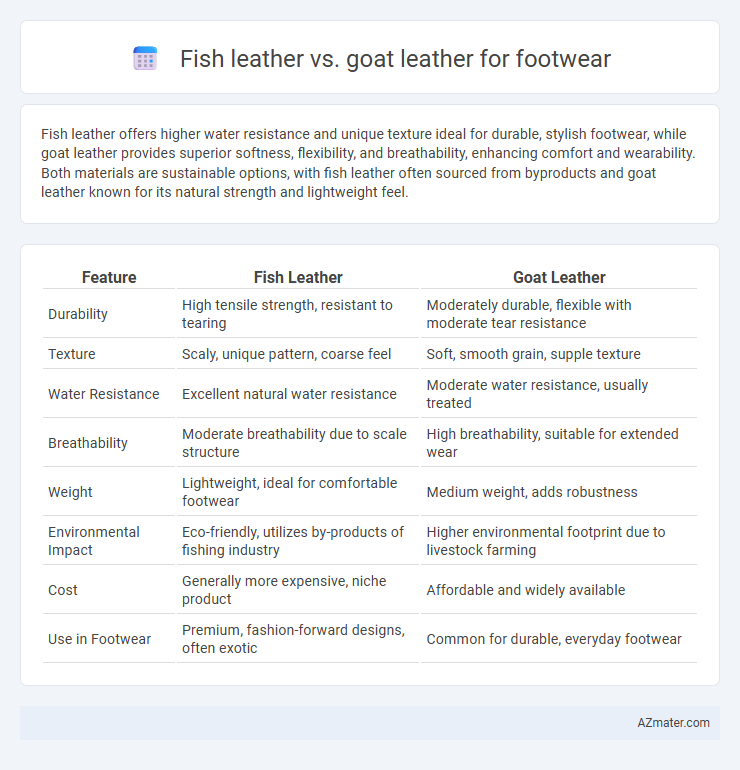Fish leather offers higher water resistance and unique texture ideal for durable, stylish footwear, while goat leather provides superior softness, flexibility, and breathability, enhancing comfort and wearability. Both materials are sustainable options, with fish leather often sourced from byproducts and goat leather known for its natural strength and lightweight feel.
Table of Comparison
| Feature | Fish Leather | Goat Leather |
|---|---|---|
| Durability | High tensile strength, resistant to tearing | Moderately durable, flexible with moderate tear resistance |
| Texture | Scaly, unique pattern, coarse feel | Soft, smooth grain, supple texture |
| Water Resistance | Excellent natural water resistance | Moderate water resistance, usually treated |
| Breathability | Moderate breathability due to scale structure | High breathability, suitable for extended wear |
| Weight | Lightweight, ideal for comfortable footwear | Medium weight, adds robustness |
| Environmental Impact | Eco-friendly, utilizes by-products of fishing industry | Higher environmental footprint due to livestock farming |
| Cost | Generally more expensive, niche product | Affordable and widely available |
| Use in Footwear | Premium, fashion-forward designs, often exotic | Common for durable, everyday footwear |
Introduction to Fish Leather and Goat Leather
Fish leather, derived from species like salmon, cod, and perch, offers a unique texture and exceptional durability due to its dense collagen structure, making it an innovative choice for sustainable footwear. Goat leather, known for its softness, flexibility, and natural breathability, has been a traditional material in footwear manufacturing, prized for its lightweight yet strong qualities. Both materials present distinct advantages, with fish leather standing out for its eco-friendly sourcing and goat leather favored for comfort and versatility in shoe design.
Unique Properties of Fish Leather for Footwear
Fish leather offers exceptional durability and flexibility due to its dense fiber structure, making it highly resistant to stretching and wear compared to goat leather. Its natural scale patterns provide a unique aesthetic appeal, adding texture and originality to footwear designs. Fish leather also boasts superior water resistance and breathability, enhancing comfort and longevity for footwear applications.
Characteristics of Goat Leather in Shoe Making
Goat leather in footwear is prized for its durability, natural water resistance, and supple texture, providing comfort and long-lasting wear. Its fine grain and lightweight properties allow for excellent breathability and flexibility, making it ideal for both casual and formal shoes. Goat leather also exhibits resistance to stretching and creasing, enhancing the overall shape retention and aesthetic appeal of footwear.
Durability: Fish Leather vs Goat Leather Shoes
Fish leather, particularly from species like salmon and cod, offers exceptional durability due to its dense fiber structure, making it highly resistant to stretching and tearing in footwear applications. Goat leather, valued for its flexibility and softness, provides good durability but tends to show wear more quickly under heavy use compared to fish leather. Footwear crafted from fish leather benefits from superior toughness and water resistance, extending shoe lifespan in demanding environments relative to traditional goat leather shoes.
Sustainability and Eco-Friendliness Comparison
Fish leather outperforms goat leather in sustainability due to its use of byproducts from the fishing industry, reducing waste and minimizing environmental impact. Its tanning process typically involves fewer toxic chemicals and less water consumption compared to goat leather production, making it more eco-friendly. Fish leather's rapid regeneration rate compared to goats also contributes to a lower carbon footprint in footwear manufacturing.
Breathability and Comfort in Daily Wear
Fish leather offers superior breathability due to its natural porous structure, allowing better air circulation and moisture management compared to goat leather. Goat leather, while durable and soft, tends to be less breathable, sometimes causing discomfort during extended daily wear. Footwear made from fish leather provides enhanced comfort in warm climates or active use by reducing sweat buildup and improving overall foot ventilation.
Fashion Versatility and Aesthetic Appeal
Fish leather offers a unique texture and iridescent finish that enhances fashion versatility, making footwear stand out with a distinct, edgy aesthetic. Goat leather, known for its soft grain and durability, provides a classic and versatile appearance suitable for both casual and formal footwear designs. The choice between fish and goat leather depends on the desired style impact, with fish leather favoring innovative, fashion-forward looks and goat leather supporting timeless elegance.
Maintenance and Care Requirements
Fish leather requires gentle cleaning with a soft cloth and mild soap to prevent damage due to its delicate scales and thinner texture, while goat leather offers higher durability and can withstand more rigorous cleaning methods. Both materials benefit from regular conditioning to maintain flexibility and prevent drying, but goat leather is less prone to cracking and easier to maintain. Proper storage away from direct sunlight and moisture is essential for both to extend their lifespan in footwear applications.
Price Points and Market Availability
Fish leather, derived primarily from species like salmon and perch, tends to be more expensive than goat leather due to its unique texture, durability, and limited production scale, with prices averaging 20-40% higher. Goat leather, widely available and traditionally used in footwear, offers more affordable price points and consistent supply, making it a preferred choice for mass-market shoes. Market availability favors goat leather due to established tanning industries and global demand, while fish leather remains niche, primarily used in luxury and eco-friendly footwear segments.
Conclusion: Choosing the Right Leather for Footwear
Fish leather offers exceptional durability, water resistance, and unique texture, making it ideal for high-performance or fashion-forward footwear. Goat leather provides superior breathability, softness, and flexibility, ensuring comfort and longevity in everyday wear. Selecting the right leather depends on prioritizing durability and aesthetics with fish leather or comfort and versatility with goat leather.

Infographic: Fish leather vs Goat leather for Footwear
 azmater.com
azmater.com